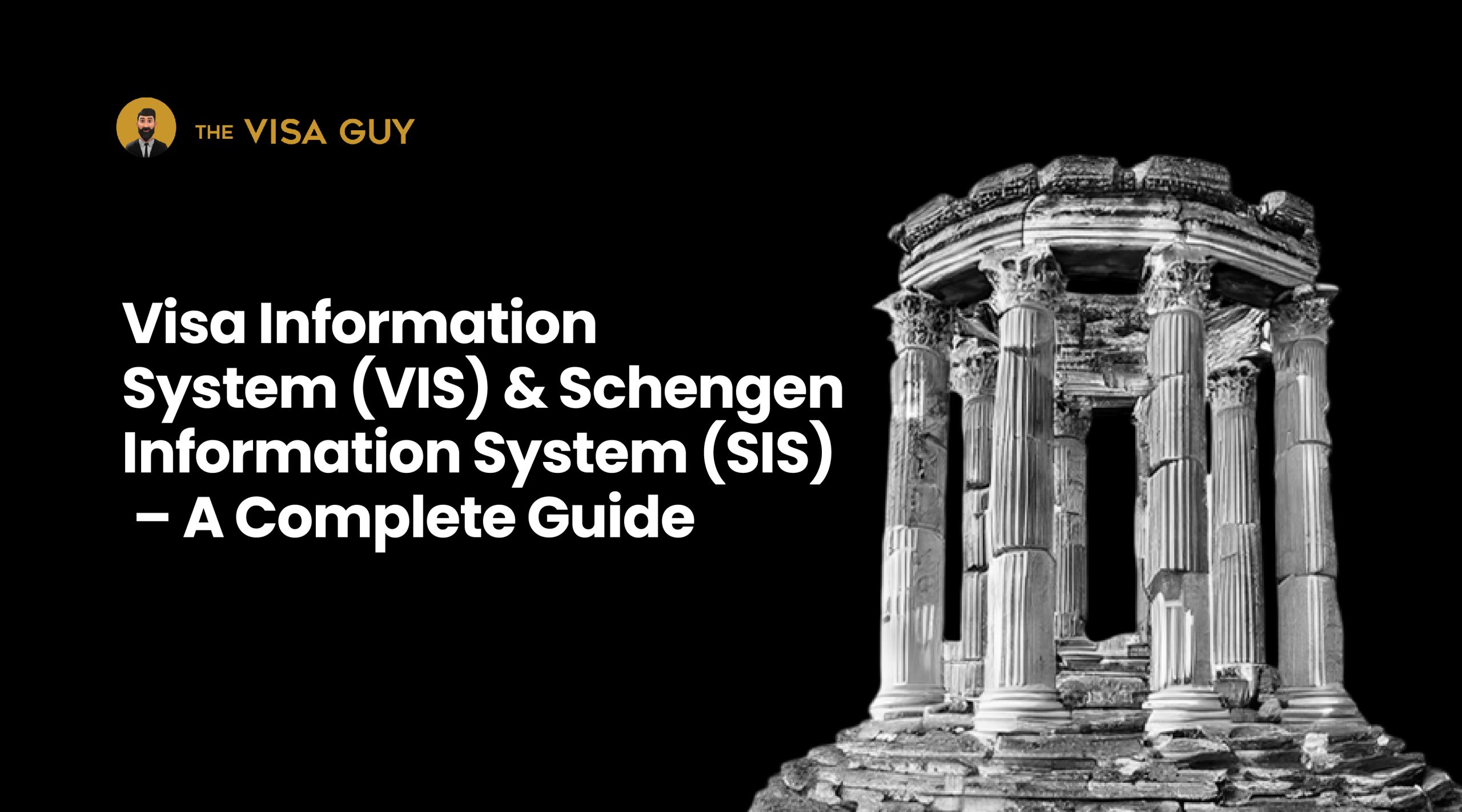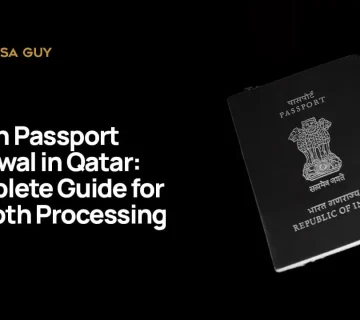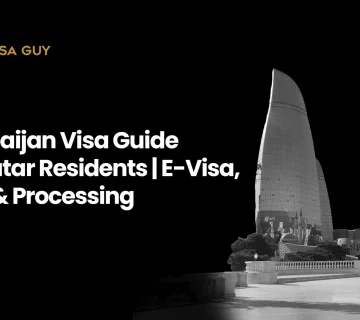Visa Information System (VIS) vs. Schengen Information System (SIS)
What are these systems made for?
If you’re traveling to Schengen countries from Qatar, your information is stored in these databases. However, the Visa Information System (VIS) and the Schengen Information System (SIS) differ slightly in their functionalities.
Let’s take a closer look at how the Visa Information System varies from the Schengen Information System.
What is the Visa Information System?
Think of VIS as a big, shared database for visa information. When someone applies for a Schengen visa, their details (including fingerprints and a photo) are stored in the visa information system.
The primary objective?
This helps Schengen countries check who is applying for visas and helps to prevent people from using fake visas. So, it is easier for the officials at the border to verify identity at border crossings.
If you’re contemplating how exactly the Visa Information System works, in simpler terms:
When you apply for a Schengen visa, your biometric data is collected—this includes your fingerprints and a digital photo. This information is stored in the VIS database and linked to your visa application.
When you arrive at a Schengen border, border guards check your fingerprints against the system to verify your identity.
VIS lets Schengen countries track your visa application. They can see if you’ve applied before, if you’ve had visas in the past, and if you’ve overstayed any visas. This helps them understand your travel history. Also, they see if someone tries to use a fake visa. In essence, VIS helps authorities keep a record of who has applied and traveled in the Schengen area.
Established in 2004 and operational since 2011, the VIS makes it easier for Schengen travellers like you to experience quicker and more efficient border checks.
Hence, you have a smoother travel experience. It also makes the visa application process more straightforward and efficient.
Do you have an overview of the Visa Information System?
Here’s what you need to know about the Schengen Information System.
What is the Schengen Information System (SIS)?
The Schengen Information System (SIS) is an extensive, shared database used by Schengen countries to maintain security. Imagine it as a warning system that helps them keep track of potential threats.
SIS strengthens border control and security. It allows border guards and law enforcement to quickly access information about people and objects they need to watch. This helps them prevent crime and protect the Schengen Area.
SIS helps monitor travelers by storing alerts about people who might be security risks. They track criminals by including information on people wanted for arrest or extradition. If someone loses their passport or car, they enters the details into SIS. This lets border guards know if someone tries to use a stolen document or vehicle.
SIS issues different types of alerts, including:
- Arrest Alerts: Countries issue these alerts for people they want to arrest.
- Refusal of Entry Alerts: Countries issue these alerts for people who are not allowed to enter the Schengen Area.
- Missing Persons Alerts: Countries issue these alerts for people who have gone missing.
- Object Alerts: Countries issue these alerts for stolen items, like cars, documents, or firearms.
- Surveillance Alerts: Countries issue these alerts for people or objects under surveillance.
Basically, SIS helps authorities quickly share critical information, and it helps the authorities to act fast to protect the security of the Schengen Area.
Why Are VIS and SIS Important for Qatar Travelers?
Hello traveler from Qatar to Schengen! Ever wondered about those acronyms, VIS and SIS, that pop up when you’re dealing with Schengen visas?
They might sound a bit technical, but they actually play a big role in making your travel smoother and safer. Let’s break it down in a way that’s easy to understand.
Think of the Visa Information System (VIS) as a big, secure digital filing cabinet for Schengen visa applications. When you, as a Qatar resident, apply for a Schengen visa from qatar for the first time, or sometimes after a while, you’ll likely have your fingerprints and a photo taken. This information gets stored in VIS.
Now, here’s where it gets handy! When you apply for another Schengen visa in the future, the system can quickly check if you’ve applied before. This speeds things up for you. The authorities have your basic info on file, so they don’t need to go through the entire process from scratch every single time.
It’s like having your records readily available, making the application process more efficient and less time-consuming for you. Plus, it helps prevent someone else from trying to use your identity to apply for a visa.
The Schengen Information System (SIS) is like a shared alarm system for all the Schengen countries. It’s a massive database that contains alerts about individuals who might pose a risk, for example, those involved in criminal activities or who have overstayed their previous visas.
So, how does this help you, the Qatar traveler?
Well, when you apply for a visa or when you’re traveling through the Schengen area, the authorities can quickly check SIS.
This helps them identify potential security threats and prevent illegal immigration.
By having this system in place, Schengen countries can better protect their borders and ensure the safety of everyone within the zone, including you!
It contributes to a more secure travel environment for everyone.
How Does the VIS Work for Schengen Visa Applications?
The Visa Information System (VIS) plays a key role in processing Schengen visa applications. It ensures security and efficiency.
When you apply for a Schengen visa, you give your biometric (Fingerprints, Digital Photos) data. Officials take your fingerprints and a digital photo. They store this data in the VIS database. This biometric data links directly to your visa application, and it allows them to confirm your identity.
They keep your biometric data in the VIS system for 59 months (almost five years). This allows Schengen countries to access your information if you apply for another visa within that time frame. After 59 months, they delete the data.
Remember, not everyone has to give their fingerprints. Children under 12 years old are not provided them.
Also, heads of state and members of national governments and their accompanying spouses, and members of official delegations when invited by Member States’ governments or by international organizations, are exempt.
People who physically cannot provide fingerprints are also exempt. However, they must provide a medical certificate. In some very rare cases, if a person has provided fingerprints within the previous 59 months, they may be able to reuse them. Each country has the final say on if they will allow this.
How Does the SIS Work at Border Control?
The Schengen Information System (SIS) is crucial for border control within the Schengen Area. It helps authorities quickly verify travelers’ information.
When you arrive at a Schengen border, border guards check your passport. They scan it and enter your details into their computer system. This system connects to the SIS database.
The system compares your information against the alerts stored in SIS. They check if your name or passport matches any alerts for wanted persons, missing persons, stolen documents, or people not allowed to enter the Schengen Area. This allows them to quickly confirm your status and make sure you are allowed to enter.
If the system flags you in SIS, it means your information matches an alert. The border guards will then take further action. What happens next depends on the type of alert:
- Arrest Alert: They will detain you and contact the relevant authorities.
- Refusal of Entry Alert: They will deny you entry into the Schengen Area.
- Missing Persons Alert: They will contact the relevant authorities to investigate.
- Object Alert: If the alert is for a stolen object, they will investigate further.
- Surveillance Alert: They may increase surveillance on you.
Common Issues Qatar Travelers May Face with VIS & SIS
As a Schengen traveller from Qatar, here are some VIS and SIS issues you may face due to simple mistakes. Let’s check what they are and how to avoid them.
Here are some reasons for Schengen Visa Rejections Related to VIS:
- If your visa application has missing or wrong details, VIS can flag it.
- If you overstayed a previous visa or had a visa refused before, VIS will record this.
- If your fingerprints or photo are unclear or don’t match previous records, VIS can cause issues.
- If the information in VIS suggests you pose a security risk, they will reject your visa.
What to Do if Flagged in SIS:
- If border guards flag you in SIS, stay calm and cooperate.
- Ask them why you are flagged and request documentation.
- You may need to provide additional information or documentation to clear the issue.
- Seek legal advice if you believe the flag is incorrect.
Also Read: 10 Common Schengen Visa Rejection Reasons and How to Avoid Them
How to Resolve Visa or Travel Restrictions
If they reject your visa, review the reasons and correct any errors. You can reapply with accurate information.
If you are flagged in SIS, gather any evidence that proves your innocence or corrects the inaccurate information. Contact the embassy or consulate of the country that issued the alert.
If the issue is complex, consult an immigration lawyer who specializes in Schengen travel. They can help you understand your rights and take appropriate action.
Always keep copies of all visa applications, travel documents, and any correspondence with the authorities. Also, consult a Schengen visa service provider like us—we’ll guide you every step of the way with accurate information. This will help you avoid trouble at the border and make your Schengen journey stress-free.
So, while you’re planning your Schengen trip from Qatar, remember that having genuine visa assistance by your side can make your trip easier, smoother, and more memorable.
For Schengen visa assistance, contact The Visa Guy—our doors are always open to help you!
FAQ’s
How does the Schengen Information System (SIS) affect travelers?
SIS is a security database. If your name is in SIS for any reason (like a crime or a lost passport), it can cause delays or problems at Schengen borders.
How long is my biometric data stored in VIS?
Your fingerprints and photo stay in the VIS system for 59 months (almost 5 years).
Can I check if I am listed in the Schengen Information System (SIS)?
Directly checking SIS is difficult. You generally find out if you’re listed when border guards check your passport. If you suspect you’re listed, you might need legal advice
Will a previous Schengen visa refusal appear in VIS?
Yes, VIS records all visa applications, including refusals. This information helps Schengen countries decide on future applications.
What should I do if I am flagged in SIS?
If you’re flagged, stay calm. Ask the border guard why. You may need to provide documents to prove your identity or clear up any misunderstandings. If you think it’s wrong, get legal help.
Right, let’s address these common questions from a visa service perspective, keeping it simple and direct:
What is the purpose of the Visa Information System (VIS)?
VIS helps Schengen countries share visa information. It makes visa checks faster and stops people from using fake visas. It’s about making travel safer for everyone.
Can an SIS alert lead to visa rejection?
Yes, absolutely. If an SIS alert suggests you’re a security risk, they will likely reject your visa.





